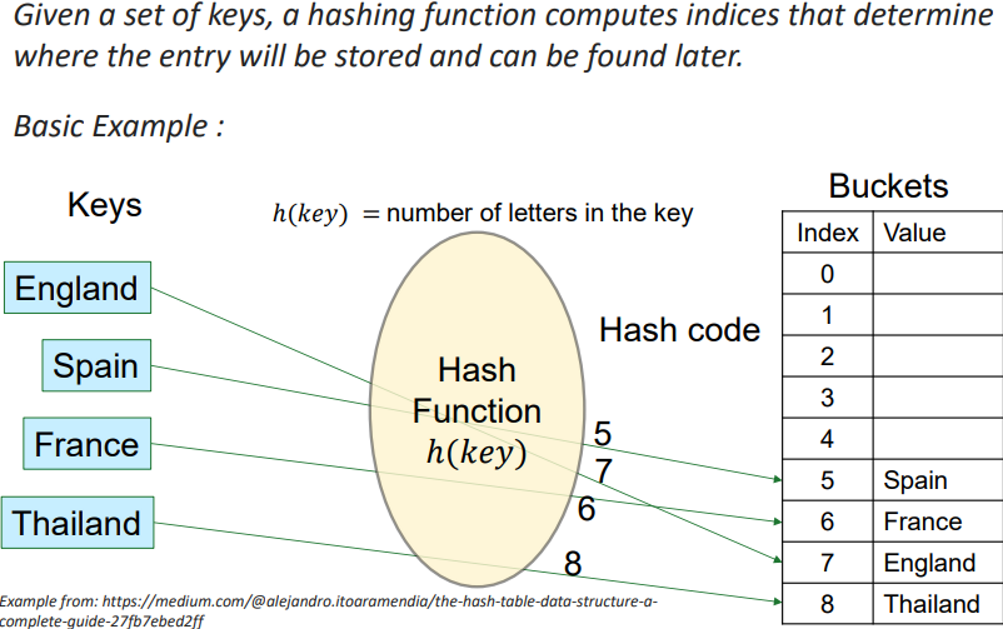Hashing
1/22
There's no tags or description
Looks like no tags are added yet.
Name | Mastery | Learn | Test | Matching | Spaced |
|---|
No study sessions yet.
23 Terms
Hashing Function
Converts a key (often a string) to an integer
Integer is used for indexing a storage array
The same deterministic function is used for storing and retrieving data
Index integer is not just restricted to 0 to 25
Hence, data can be spread across a much longer array
How do we Deal with Collisions?
chaining
Hash Table
data structure that is designed to be fast to work with
Hash Function
takes the key of an element to generate a hash code
maps keys to array indices
Hash Code
says what bucket the element belongs to, so we can now find it assuming no collisions
Buckets
array indices
where the elements are stored
What is the Unique Part of an Element?
the key
How does Hashing Work? (diagram)

Increasing Range of Indexes
For more objects (more keys), need longer array to minimise collisions
Hashing function needs to produce a large range of integers
Use more information from each key
e.g. all letters, and perhaps length
But, just adding these together, a 15-letter key will rarely give an index, say, over 300
Designing a Good Hashing Function
minimise collisions
get a wide range of index values
Minimising Collisions
a wide range of index values and
unform hashing (each key is equally likely to map to an array location)
Getting a Wide Range of Index Values
use multiplication as well as addition
Dealing with Large Indices
If we want to use an array of length size, we can use:
index = rawIndex%size:
where % is the integer remainder operation (modulo)
e.g. to store 50 or so words, choose size = 100:
key = "pace", rawIndex = 71671
index = 71671%100 = 71
key = "cart", rawIndex = 345438
index = 345438%100 = 38
The Hashing Pitfall
Note that hash retrieval has two stages:
Use hashing function to compute index
Search chain in array element to see if there is a match
With a good hashing function and a large array, Stage 2 can be close to O(1), but, Stage 1 should also be fast
Real-World Hashing Functions…
avoid slow multiplication and division operations
use fast logical shift and ‘OR’ operations
Multiplication vs Bit Shifting
Multiplication is a slow operation
Where the multiplier is a power of 2, we can left shift the bits in the multiplicand (X) by the power of 2 instead, and get exactly the same answer

Why do we use Key-Value Pairs?
to distinguish between key-value pairs with the same hash
Key
unique input to hash function that is translated by hash function
Value
what we put in the bucket associated with the key
Hash Table ADT
Stores key-value pairs
Keys are unique and a handle to the associated value
Operations
put(t, k) stores k in the table t
get(t, k) returns if k is in t else nil
delete(t, k) removes k from t
Hash Table ADT Pseudocode
//chains are lists; A is hash table array
put(t, <k,v>) {
chain = t.A[hash(k)]
//C doesn't have to be sorted
add(chain, <k,v>)
}
get(t, k) {
chain = t.A[hash(k)]
return search(chain,k)
}
delete(t, k) {
chain = t.A[hash(k)]
remove(chain,k)
}What Happens if Chains Grow too Long
Hash tables become less efficient
Avoiding Chains Growing too Long
hash table allocates double the size of current array
then puts each in current array into larger array
expensive operation
invisible to the user of the ADT